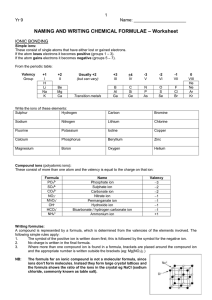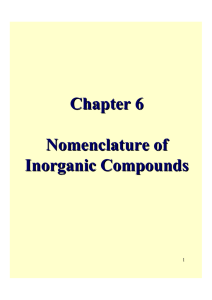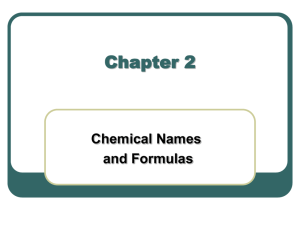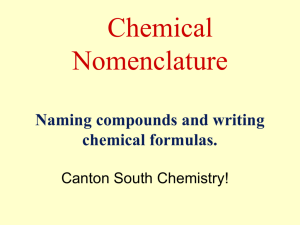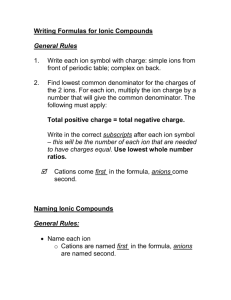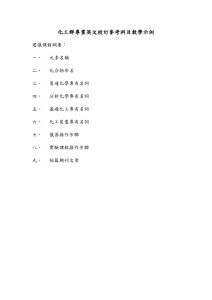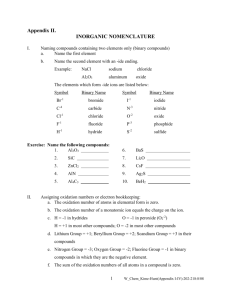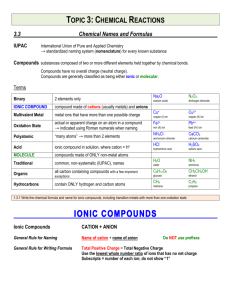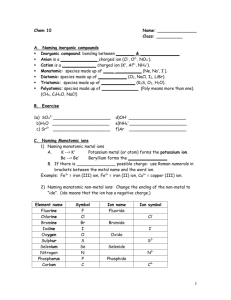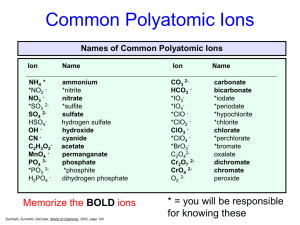Lab 5 Inorganic Nomenclature
advertisement
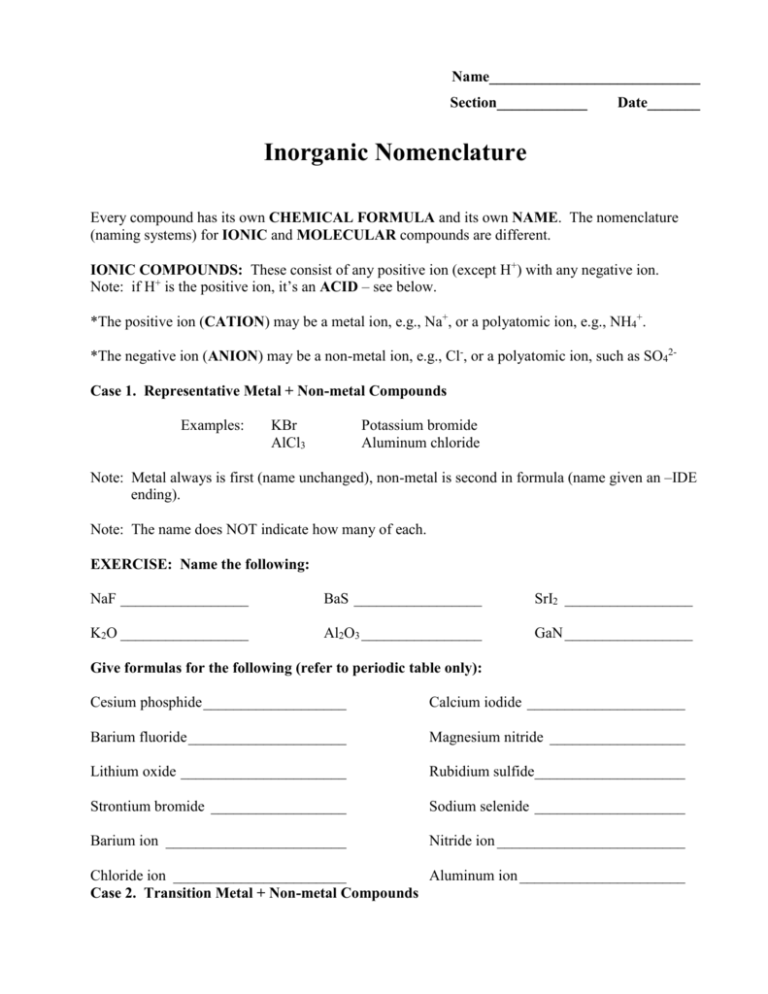
Name____________________________ Section____________ Date_______ Inorganic Nomenclature Every compound has its own CHEMICAL FORMULA and its own NAME. The nomenclature (naming systems) for IONIC and MOLECULAR compounds are different. IONIC COMPOUNDS: These consist of any positive ion (except H+) with any negative ion. Note: if H+ is the positive ion, it’s an ACID – see below. *The positive ion (CATION) may be a metal ion, e.g., Na+, or a polyatomic ion, e.g., NH4+. *The negative ion (ANION) may be a non-metal ion, e.g., Cl-, or a polyatomic ion, such as SO42Case 1. Representative Metal + Non-metal Compounds Examples: KBr AlCl3 Potassium bromide Aluminum chloride Note: Metal always is first (name unchanged), non-metal is second in formula (name given an –IDE ending). Note: The name does NOT indicate how many of each. EXERCISE: Name the following: NaF _________________ BaS _________________ SrI2 _________________ K2O _________________ Al2O3 ________________ GaN _________________ Give formulas for the following (refer to periodic table only): Cesium phosphide ___________________ Calcium iodide _____________________ Barium fluoride _____________________ Magnesium nitride __________________ Lithium oxide ______________________ Rubidium sulfide____________________ Strontium bromide __________________ Sodium selenide ____________________ Barium ion ________________________ Nitride ion _________________________ Chloride ion _______________________ Aluminum ion ______________________ Case 2. Transition Metal + Non-metal Compounds In general, the ions formed by the transition metals are not predictable. MEMORIZE those given on the last page of handout (Index cards are very helpful). *If the transition metal forms only 1 ion, name the compound as in Case 1. Examples: ZnCl2 Ag2S Zinc chloride Silver sulfide *If the transition metal can form more than one type of ion, name the compounds with on or both of two systems (each compound has 2 names). Name 1 Name 2 2+ 2Examples: FeO [formed from Fe and O ] Iron (II) oxide or ferrous oxide Fe2O3 [formed from Fe3+ and O2-] Iron (III) oxide or ferric oxide The –ous ending refers to the ion with the lower charge state, e.g., Fe2+, Cu+ (cuprous). The –ic ending refers to the ion with the higher charge state, e.g., Fe3+, Cu2+ (cupric). Note: the modern names for cuprous and cupric ions would be copper (I) and copper (II), where the roman numeral in parentheses corresponds to the number of charges. Note: For each compound you must learn both the modern (includes roman numeral) name and the older name. Note: Lead and tin form 2+ and 4+ ions even though they are not transition metals. EXERCISE: After you have learned the ions on the back page, name the following using both systems: Pb2+ _____________ Sn4+ _____________ Fe2+ _____________ Cu2+ ____________ _____________ _____________ _____________ ____________ Name the following compounds (two names if appropriate): AgCl ___________________ FeBr3 ___________________ From the three compounds above, what is the charge on Fe? Cu3N __________________ on Cu? Give formulas for the following compounds: Chromic oxide____________ Nickel fluoride____________ Ferrous iodide ___________ Ferric oxide ______________ Cuprous sulfide ___________ Plumbic chloride _________ Cases 1 and 2 (above) involve ionic compounds which consist only of a metal cation and a nonmetal anion – two elements only. These are called BINARY compounds and consist of two MONOATOMIC ions. Ionic compounds can also be formed from more complex, polyatomic ions. Case 3. Ionic Compounds with POLYATOMIC Ions The list of polyatomic ions (names and formulas) which must be learned are on the back page of the handout. For compounds, the cation is named first, then the anion: Examples: *Question: (NH4)2S K3PO4 Fe2(SO4)3 Ammonium sulfide Potassium phosphate Iron (III) sulfate or ferric sulfate* How do you know it’s Fe3+ and not Fe2+ in ferric sulfate???? Note: Parentheses ( ) are used only when there are 2 or more polyatomic ions in the formula. Exercise: Name the following: (NH4)2O______________________________ FeC2O4 _______________________________ Na2SO3 ______________________________ CuNO3 _______________________________ LiSCN _______________________________ NaHCO3 ______________________________ Give formulas for the following: Cupric nitrate ____________ Zinc phosphate ___________ Silver carbonate __________ Chromic hydroxide ________ Mercuric cyanide __________ Lead (IV) acetate _________ Potassium dichromate ______ Nickel hydroxide __________ Barium permanganate _____ Calcium carbonate ________ Potassium chlorate_________ Cadmium sulfate _________ Mercurous iodide _________ Ammonium phosphide _____ Cobaltous nitrite__________ Fill in the Formula and name each compound. For iron and copper compounds, give old and new names. CO32- HCO3- CrO42- NO3- NO2- OH- SO42- HSO4- SO32- HSO3- PO43- CrO42- MnO4- C2H3O2- Al3+ Mg2+ Cu+ Cu2+ Fe3+ Ag+ Fe2+ Case 4. Naming ACIDS ACIDS (from the Latin word acidus, meaning “sour”) are an important class of compounds and are defined as a substance whose molecules each yield one or more hydrogen ions (H+) when dissolved in water. The formula for an acid is formed by adding sufficient H+ ions to balance the anion’s charge. The name of the acid is related to the name of the anion and includes the label acid. Anions whose names end in –ide have associated acids that have the hydro- prefix and an –ic ending. Example: ANION CORRESPONDING ACID Cl- HCl (hydrochloric acid) Many of the most important acids are derived form OXYANIONS (polyatomic ions which contain oxygen). Oxyanions whose names end in -ite (sulfite, nitrite, chlorite, etc.) have associated acids whose names end in –ous, Examples: SO32- (sulfite) ClO2- (chlorite) H2SO3 HClO2 sulfurous acid chlorous acid Oxyanions whose names end in –ate (sulfate, phosphate, nitrate, chlorate, etc.) have corresponding acids whose names are given in –ic ending, Examples: SO42- (sulfate) ClO3- (chlorate) H2SO4 HClO3 sulfuric acid chloric acid Note: Chlorite and chlorate ions are not included in the attached table but are legitimate oxyanions of chlorine and quite common. Exercise: a) Give the appropriate formula for the corresponding acids of the following anions and b) name the acid: Sulfide a) _________ b) ____________________________ Carbonate a) _________ b) ____________________________ Oxalate a) _________ b) ____________________________ Phosphate a) _________ b) ____________________________ Acetate a) _________ b) ____________________________ Nitrite a) _________ b) ____________________________ - 40 - Case 5. Naming BINARY MOLECULAR COMPOUNDS MOLECULAR COMPOUNDS are the compounds formed when non-metal atoms SHARE electrons with other non-metal atoms. BINARY molecular compounds consist of two different atoms and should be named in the following way: Similar to ionic compounds, the more positive ion is first and the more negative ion is second with the negative ion’s name including an –ide ending. To determine which is the most positive or negative compare relative electronegativities. Unlike ionic compounds, the number of each atom is specified with a prefix: 1 – mono 2 – di 3 – tri 4 – tetra 5 – penta 6 – hexa 7 – hepta 8 – octa 9 – nona 10 – deca If there is only one of the first atom, the mono prefix is not used. Examples: NO NO2 nitrogen monoxide nitrogen dioxode N2O IF7 dinitrogen monoxide iodine heptafluoride Exercise: Name the following: N2O3 ________________________________ N2O5 _________________________________ N2O4 ________________________________ CO __________________________________ CO2 _________________________________ Cl2O _________________________________ P2O5 _________________________________ N2 ___________________________________ Give the formulas for the following: Iodine pentabromide ____________________ Chlorine trifluoride _____________________ Oxygen difluoride ______________________ Carbon tetrafluoride_____________________ Sulfur hexafluoride _____________________ Silicon dioxide _________________________ Hydrogen_____________________________ Ammonia _____________________________ Iodine heptafluoride ____________________ Dibromine monoxide ____________________ Sulfur trioxide _________________________ Tetraphosphorus decaoxide _______________ - 41 - Common Ions Positive Ions (CATIONS) Negative Ions (ANIONS) - 42 - +1 Charge Ammonium (NH4+)* Copper (I) or cuprous (Cu+)* Hydrogen (H+) “proton”* Hydronium (H3O+) “aqueous proton”* Silver (Ag+)* +2 Charge Cadmium (Cd2+) Cobalt (II) or cobaltous (Co2+) Copper (II) or cupric (Cu2+)* Iron (II) or ferrous (Fe2+)* Lead (II) or plumbous (Pb2+)* Manganese (II) or manganous (Mn2+)* Mercury (I) or mercurous (Hg22+)* Mercury (II) or mercuric (Hg2+)* Nickel (Ni2+)* Tin (II) or stannous (Sn2+)* Zinc (Zn2+)* +3 Charge Aluminum (Al3+)* Chromium (III) or chromic (Cr3+)* Iron (III) or ferric (Fe3+)* +4 Charge Lead (IV) or plumbic (Pb4+)* Tin (IV) or stannic (Sn4+)* -1 Charge Acetate (C2H3O2-)* Perchlorate (ClO4-) - 43 - Chlorate (ClO3-) Chlorite (ClO2-) Hypochlorite (ClO-)* Cyanide (CN-) Dihydrogen phosphate (H2PO4-)* Hydrogen carbonate or bicarbonate (HCO3-)* Hydrogen sulfate or bisulfate (HSO4-)* Hydrogen sulfite or bisulfite (HSO3-)* Hydroxide (OH-)* Nitrate (NO3-)* Nitrite (NO2-)* Permanganate (MnO4-)* Thiocyanate (SCN-) -2 Charge Carbonate (CO32-)* Chromate (CrO42-) Dichromate (Cr2O72-) Hydrogen phosphate (HPO42-)* Oxalate (C2O42-) Sulfate (SO42-)* Sulfite (SO32-)* Peroxide (O22-)* -3 Charge Phosphate (PO4-3)* - 44 -
